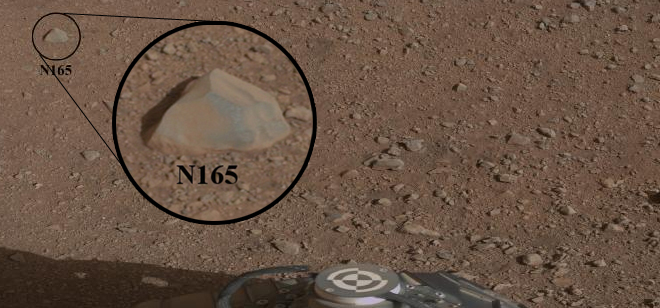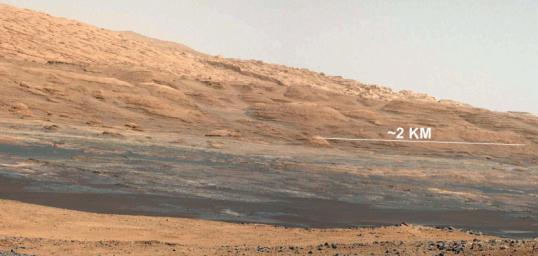

| Visitors Now: | |
| Total Visits: | |
| Total Stories: |

| Story Views | |
| Now: | |
| Last Hour: | |
| Last 24 Hours: | |
| Total: | |
Will Coronation Reveal Martian Life, Curiosity Laser Zaps First Rock With A Million Watts, Photos
NASA’s Mars rover Curiosity fired its laser for the first time on Mars, using the beam from a science instrument to interrogate a fist-size rock called “Coronation.”

The mission’s Chemistry and Camera instrument, or ChemCam, hit the fist-sized rock with 30 pulses of its laser during a 10-second period. Each pulse delivers more than a million watts of power for about five one-billionths of a second.
The energy from the laser excites atoms in the rock into an ionized, glowing plasma. ChemCam catches the light from that spark with a telescope and analyzes it with three spectrometers for information about what elements are in the target.
“We got a great spectrum of Coronation — lots of signal,” said ChemCam Principal Investigator Roger Wiens of Los Alamos National Laboratory, N.M. “Our team is both thrilled and working hard, looking at the results. After eight years building the instrument, it’s payoff time!”

Image Credit: NASA/JPL-Caltech/MSSS/LANL
ChemCam recorded spectra from the laser-induced spark at each of the 30 pulses. The goal of this initial use of the laser on Mars was to serve as target practice for characterizing the instrument, but the activity may provide additional value. Researchers will check whether the composition changed as the pulses progressed. If it did change, that could indicate dust or other surface material being penetrated to reveal different composition beneath the surface. The spectrometers record intensity at 6,144 different wavelengths of ultraviolet, visible and infrared light.
“It’s surprising that the data are even better than we ever had during tests on Earth, in signal-to-noise ratio,” said ChemCam Deputy Project Scientist Sylvestre Maurice of the Institut de Recherche en Astrophysique et Planetologie (IRAP) in Toulouse, France. “It’s so rich, we can expect great science from investigating what might be thousands of targets with ChemCam in the next two years.”

The rock is just off to the right of the rover. This image is part of a set of images obtained by Curiosity’s Mast Camera on Aug. 8 PDT (Aug. 9 EDT).
Curiosity landed on Mars two weeks ago, beginning a two-year mission using 10 instruments to assess whether a carefully chosen study area inside Gale Crater has ever offered environmental conditions favorable for microbial life.
ChemCam was developed, built and tested by the U.S. Department of Energy’s Los Alamos National Laboratory in partnership with scientists and engineers funded by the French national space agency, Centre National d’Etudes Spatiales (CNES) and research agency, Centre National de la Recherche Scientifique (CNRS).
A scale bar indicates a distance of 1.2 miles (2 kilometers). Curiosity’s 34-millimeter Mast Camera acquired this high-resolution image on Aug. 8, 2012 PDT (Aug. 9 EDT).

Image Credit: NASA/JPL-Caltech/MSSS
NASA’s Jet Propulsion Laboratory, a division of the California Institute of Technology, Pasadena, manages the Mars Science Laboratory Project, including Curiosity, for NASA’s Science Mission Directorate, Washington. JPL designed and built the rover.
More information about ChemCam is available at www.msl-chemcam.com .
Contacts and sources:
Guy Webster/D.C. Agle
Jet Propulsion Laboratory, Pasadena, Calif.




I find these photos to have been censored. Most of them have light-colored spots they say… are from when the Curiosity landed, and blew things off the surface in spots. But when I drag them into iPhoto and enlarge them, then use my contrast capabilities to ehance the spots, it looks like someone in a photo program has attempted to “smudge” the particular areas to rub out what really there…
Why they show us just a part of a arid desert.Maybe behind the hills does exist civilisation,a zone like area 51 here on Earth